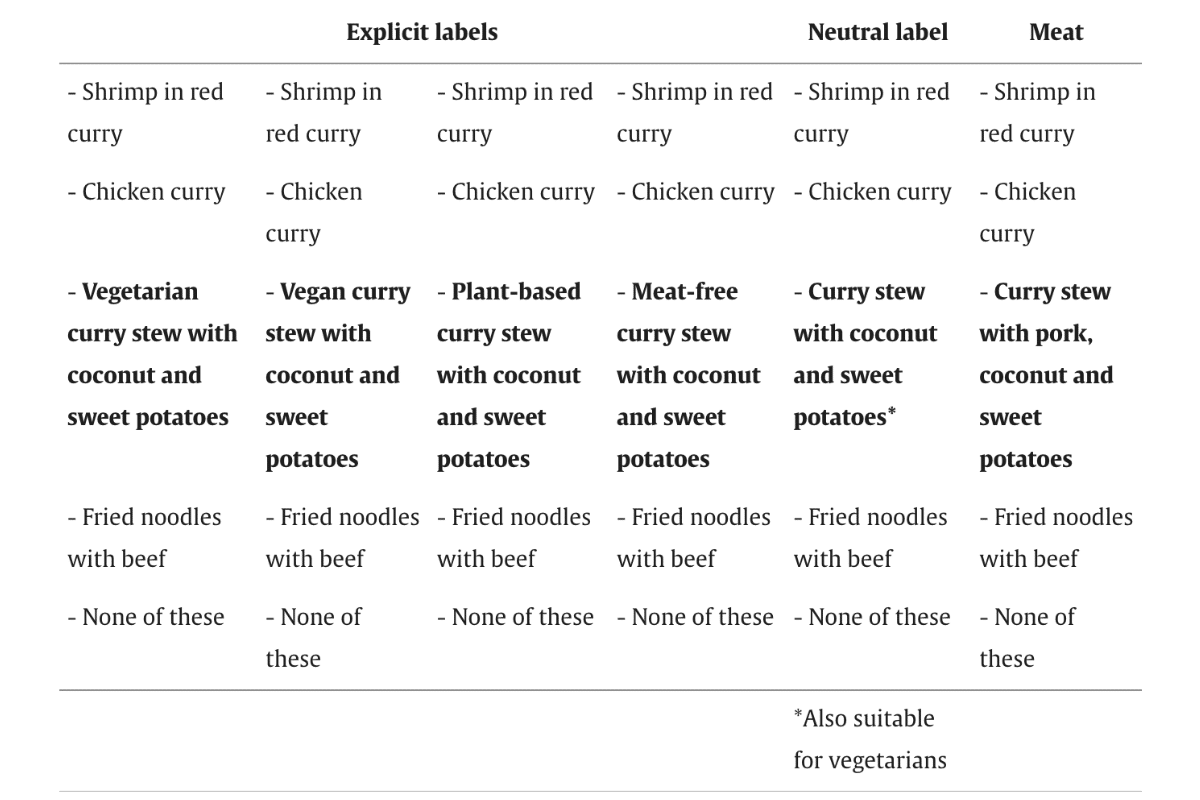
What sounds better—a healthy, low-fat vegan black bean burger or a 10-spice smoky black bean burger? What if I told you they were exactly the same? Research has shown that most people gravitate more toward foods described by flavor, not healthfulness.
Buffet-style dining halls located at five different college campuses were assigned to use three different types of labels for vegetable dishes: healthful, flavor focused, or basic.[1] Every five to six weeks, the menu was repeated at each of the schools, and each time, the vegetables were randomly assigned one of the three label choices. For example, the okra might have been labeled as either Okra and Tomatoes (basic label), New Orleans Style Okra & Creole Tomatoes (flavor-focused label), or Low Carb Okra & Tomatoes (healthful label), whereas the carrots might have been labeled as Carrots, Maple Glazed Carrots with Herbs and Lemon, or Reduced Sodium Carrots. You can review the full list of labels used in the study in the supplementary materials, if you are interested.

“Okra and Tomatoes,” “New Orleans Style Okra & Creole Tomatoes,” or “Low Carb Okra and Tomatoes”? The choice matters.
Compared to the basic labels, flavor-focused labels resulted in a 14 percent increase in vegetable selection. This makes sense. The basic label doesn’t exactly whet the appetite. What’s maybe more surprising is that flavor-focused labels performed even more impressively when compared to the healthful labels, resulting in a 29 percent increase in vegetable selection.
In a supplementary study to rule out other potential factors, the researchers added more labeling options, including labels that were fancy or vaguely positive but not in a way that suggested specific flavors. For instance, green beans were described as Sizzlin’ Garlic Parmesan Skillet Green Beans (flavor-focused label), Smart Choice Heart Health Green Beans (healthful label), Haricots Verts Green Beans a l’Italienne (fancy label), or Magnificent Green Beans (vaguely positive). As you might expect, the fancy and vaguely positive labels were more effective than the basic or health-focused labels. However, the flavor-focused label remained the most successful, scoring highest on the measure we are most focused on in this article—the likelihood of being chosen.
Is it possible that the primary study population, university students in the US, might be uniquely sensitive to labeling changes? Another study investigated similar labeling changes in workplace cafeterias located in Chicago, Sydney, São Paulo, and Singapore. The researchers arrived at a similar conclusion: changing vegetable dish names to be more appealing and sensory led to a nearly 44 percent increase in those dishes being taken.[2] Some examples include changing the label for Eggplant and Chickpea Stew to Nonna’s Garden Ragout, and changing Seitan Stew to Wine Simmered French Vegetable Medley.

“Eggplant and Chickpea Stew” or “Nonna’s Garden Ragout”?
What about labels including words like vegetarian or vegan? In 2022, Hielkema and Lund showed a group of Danish meat eaters one of six menus and asked them to imagine they were having dinner at an Asian restaurant.[3] “Which dish would you want to order?” they asked. The menus were the same, except for one item. The table below shows the different menus.

“Overview of the six different menus used in the online survey experiment” by Hielkema and Lund.3 CC-BY
The researchers found that when they provided the neutral menu, the curry was 2.6 times more likely to be selected than when the dish was explicitly labeled as vegetarian, vegan, plant-based, or meat free. Even among participants who were actively reducing their meat intake, the neutrally labeled curry was more than twice as likely to be selected (30.1 percent) as the explicitly labeled curry (14.4 percent). This study suggests that neutral labeling—while perhaps less convenient for already committed vegetarians or vegans—is the way to go when trying to appeal to a wider audience.
Several real-world examples back this up. At Sainsbury’s, one of the largest grocery retailers in the UK, changing the name of one of their breakfast items from Vegetarian Sausages and Mash to Cumberland-Spiced Veggie Sausages and Mash led to a 76 percent increase in sales.[4] Likewise, in the US, when Panera Bread changed the label of their black bean soup from Low Fat Vegetarian Black Bean Soup to Cuban Black Bean Soup at eighteen of their Los Angeles locations, they saw a 13 percent increase in sales of the soup.[5] (Incidentally, we might expect even greater gains in parts of the country where vegetarianism is not as prevalent as it is in Southern California.)
How you describe your food choices depends on your target audience. If you’re hoping to pique the interest of most people, particularly omnivorous folks, this research suggests you’re best off emphasizing qualities that go beyond health. Describe the dish’s flavor or use language that suggests vibrancy and tradition (e.g., Nonna’s Garden Ragout). The next time you bring your whole food, plant-based item to a potluck, consider how you might make it sound as appealing as possible.
You can surely find exceptions to this advice, particularly for talking with people who are fully committed to achieving a certain health outcome. Descriptions focused on healthfulness will likely land differently with someone who has recently had a heart attack. But even then, we can also choose language that appeals to the appetite.
Let us know what you think of the research above. Can you think of any examples in your life when changes to labeling affected choice? What about examples that contradict or complicate these findings? How might you apply this information?
This article is an edited instructor post from our Plant-Based Nutrition Certificate Program. Students in the program dive deep into the research on nutrition’s role in preventing and treating numerous diseases, as well as numerous other topics, including various social and psychological factors influencing well-being. You can learn more about the program here.
Copyright 2025 Center for Nutrition Studies. All rights reserved.
